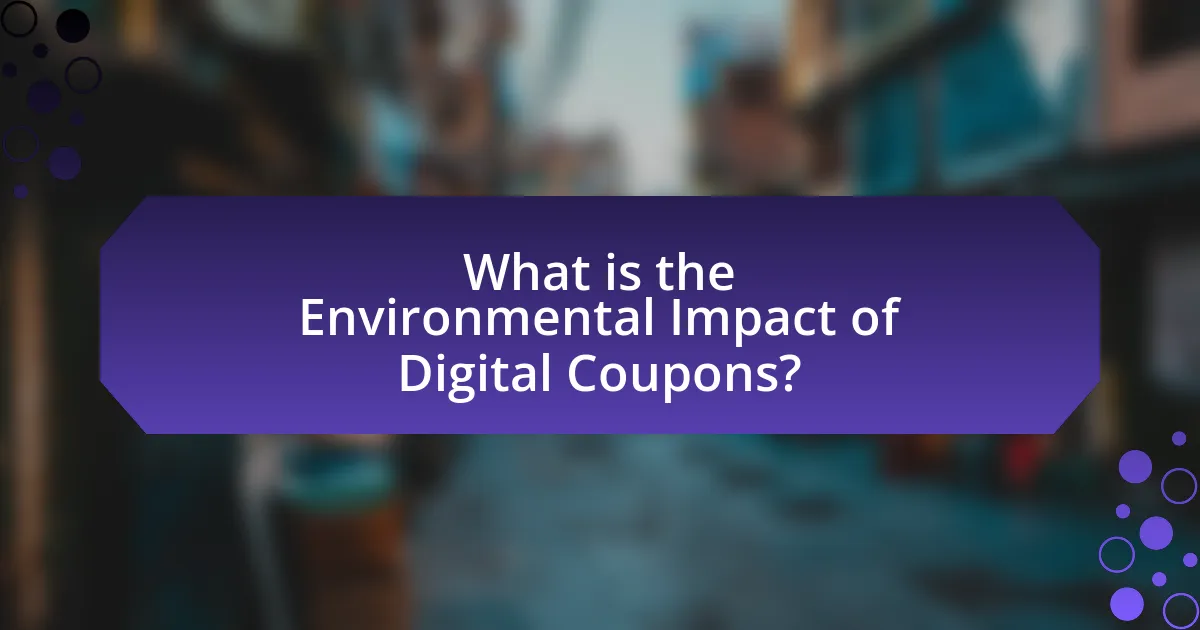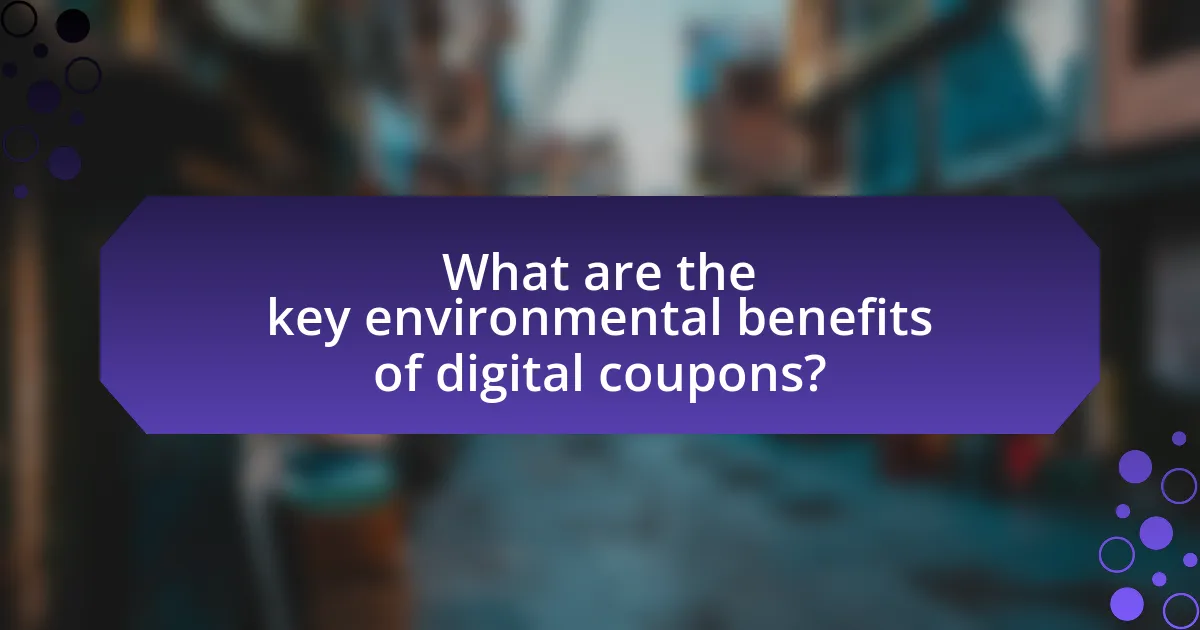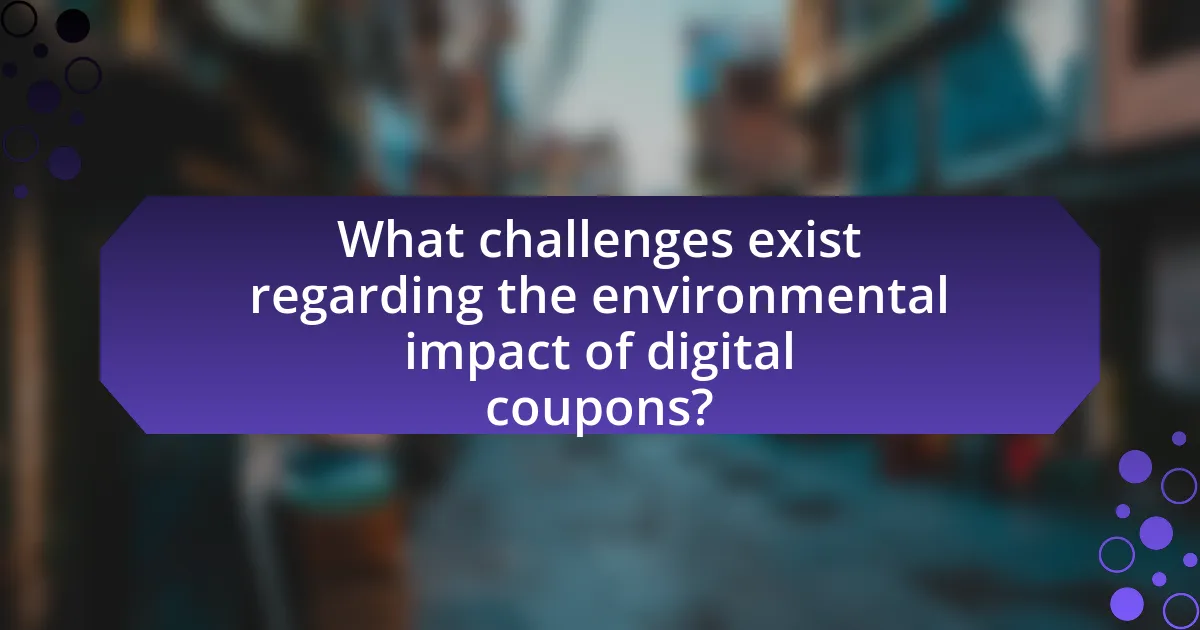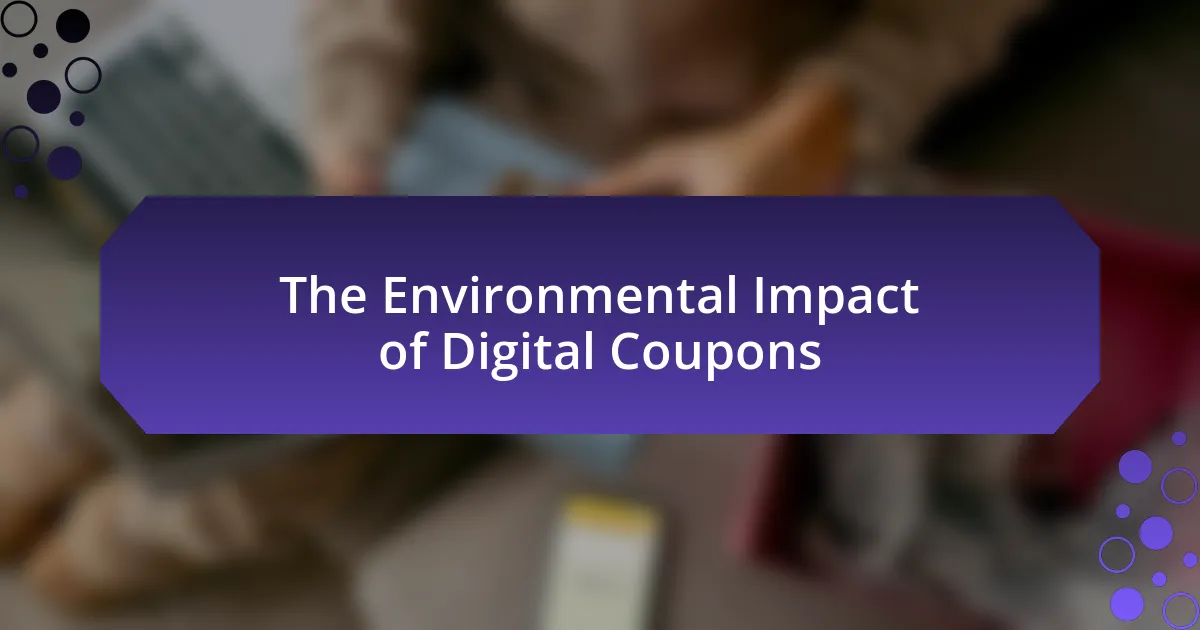The article examines the environmental impact of digital coupons, highlighting their advantages over traditional paper coupons. It details how digital coupons significantly reduce paper waste, lower carbon emissions, and minimize resource consumption associated with paper production and distribution. The discussion includes the environmental costs of paper coupons, the role of consumers in promoting sustainable practices, and the benefits for businesses adopting digital formats. Additionally, it addresses the challenges related to energy consumption and electronic waste linked to digital coupon usage, while offering strategies for both businesses and consumers to enhance sustainability in couponing practices.

What is the Environmental Impact of Digital Coupons?
Digital coupons have a lower environmental impact compared to traditional paper coupons. The shift from paper to digital formats reduces paper waste significantly, as it is estimated that producing one ton of paper requires about 24,000 gallons of water and results in substantial carbon emissions. Additionally, digital coupons eliminate the need for transportation and distribution associated with physical coupons, further decreasing their carbon footprint. Studies indicate that the adoption of digital coupons can lead to a reduction in overall resource consumption, aligning with sustainability goals in retail and consumer behavior.
How do digital coupons differ from traditional paper coupons?
Digital coupons differ from traditional paper coupons primarily in their format and distribution method. Digital coupons are accessed and redeemed electronically, often through smartphones or computers, while traditional paper coupons are physical pieces of paper that must be printed or cut out. This electronic nature of digital coupons reduces paper waste, contributing to environmental sustainability. According to a study by the Environmental Protection Agency, the production of paper contributes to deforestation and pollution, whereas digital coupons eliminate these issues by reducing the need for physical materials.
What are the environmental costs associated with paper coupons?
The environmental costs associated with paper coupons include deforestation, energy consumption, and waste generation. The production of paper coupons typically requires cutting down trees, contributing to habitat loss and biodiversity decline; for instance, it is estimated that producing one ton of paper can require up to 24,000 gallons of water and significant amounts of energy. Additionally, paper coupons often end up in landfills, where they contribute to methane emissions as they decompose. According to the Environmental Protection Agency, paper and paperboard accounted for approximately 23% of municipal solid waste in 2018, highlighting the substantial waste impact of paper products, including coupons.
How do digital coupons reduce resource consumption?
Digital coupons reduce resource consumption by eliminating the need for paper production and distribution associated with traditional coupons. The transition from physical to digital formats significantly decreases the demand for raw materials, such as trees for paper, and reduces energy consumption linked to printing and transportation. For instance, a study by the Environmental Paper Network indicates that producing one ton of paper requires approximately 24,000 gallons of water and emits significant greenhouse gases. By utilizing digital coupons, retailers and consumers contribute to lower carbon footprints and conserve natural resources, thereby promoting environmental sustainability.
Why is it important to analyze the environmental impact of digital coupons?
Analyzing the environmental impact of digital coupons is important because it helps identify their overall sustainability and resource efficiency compared to traditional paper coupons. Digital coupons can reduce paper waste, as they eliminate the need for physical printing, which in 2018 accounted for approximately 4.5 million tons of paper waste in the U.S. alone. Furthermore, understanding their environmental footprint allows businesses to make informed decisions that align with eco-friendly practices, potentially leading to reduced carbon emissions associated with production and distribution. By evaluating the energy consumption of digital platforms and the lifecycle of digital coupons, stakeholders can optimize processes to minimize environmental harm, thus promoting a more sustainable approach in the retail industry.
What role do consumers play in the environmental impact of coupon usage?
Consumers significantly influence the environmental impact of coupon usage through their choices and behaviors. When consumers opt for digital coupons over paper ones, they reduce paper waste and the carbon footprint associated with printing and distributing physical coupons. A study by the Environmental Protection Agency indicates that paper production contributes to deforestation and greenhouse gas emissions, highlighting the environmental benefits of digital alternatives. Additionally, consumer demand for eco-friendly practices encourages retailers to adopt sustainable couponing methods, further amplifying the positive environmental effects.
How can businesses benefit from adopting digital coupons?
Businesses can benefit from adopting digital coupons by increasing customer engagement and driving sales. Digital coupons streamline the redemption process, making it easier for customers to access discounts, which can lead to higher purchase frequency. According to a study by the Digital Coupon Association, 97% of consumers have used a digital coupon, indicating widespread acceptance and usage. Additionally, digital coupons reduce printing costs and paper waste, contributing to environmental sustainability. This dual advantage of enhancing profitability while promoting eco-friendliness makes digital coupons a strategic choice for businesses.

What are the key environmental benefits of digital coupons?
Digital coupons provide significant environmental benefits by reducing paper waste and minimizing carbon emissions associated with traditional coupon distribution. The transition from physical to digital formats eliminates the need for paper production, which is responsible for deforestation and water consumption; for instance, producing one ton of paper requires approximately 24,000 gallons of water. Additionally, digital coupons decrease the carbon footprint linked to transportation and logistics, as they are delivered electronically rather than through physical mail or in-store printouts. This shift not only conserves natural resources but also contributes to lower greenhouse gas emissions, supporting broader sustainability goals.
How do digital coupons contribute to waste reduction?
Digital coupons contribute to waste reduction by eliminating the need for physical paper coupons, which reduces paper waste. According to the Environmental Protection Agency, paper production is responsible for significant deforestation and water usage, with approximately 68 million trees cut down annually for paper products. By using digital coupons, consumers can access discounts without contributing to this environmental burden, thereby promoting sustainable practices. Additionally, digital coupons often lead to more efficient inventory management for retailers, reducing the likelihood of unsold products being discarded. This efficiency further supports waste reduction efforts in the retail sector.
What statistics support the reduction of waste through digital coupons?
Digital coupons significantly reduce waste, with studies indicating that they can decrease paper waste by up to 90%. According to a report by the Digital Coupon Association, the transition from paper to digital coupons has led to a reduction of approximately 1.5 billion pounds of paper waste annually. Additionally, a survey by Nielsen found that 70% of consumers prefer digital coupons over traditional paper ones, further supporting the shift towards digital formats that minimize environmental impact.
How does the reduction of paper usage impact deforestation?
The reduction of paper usage significantly decreases deforestation rates. When less paper is consumed, the demand for wood pulp diminishes, leading to fewer trees being cut down for paper production. According to the World Wildlife Fund, approximately 40% of the world’s industrial logging is for paper, which contributes to habitat loss and biodiversity decline. By minimizing paper usage, we can protect forests, maintain ecosystems, and reduce carbon emissions associated with deforestation.
In what ways do digital coupons promote sustainable practices?
Digital coupons promote sustainable practices by reducing paper waste and encouraging eco-friendly purchasing behaviors. By eliminating the need for physical coupons, digital formats significantly decrease the amount of paper used, contributing to lower deforestation rates and reduced landfill waste. According to a study by the Environmental Protection Agency, paper production is responsible for approximately 25% of landfill waste, highlighting the environmental benefits of transitioning to digital alternatives. Furthermore, digital coupons often incentivize consumers to purchase sustainable products, as retailers may offer discounts on eco-friendly items, thereby promoting a shift towards greener consumption patterns.
How can digital coupons encourage eco-friendly consumer behavior?
Digital coupons can encourage eco-friendly consumer behavior by incentivizing the purchase of sustainable products and reducing paper waste. By offering discounts on eco-friendly items, retailers can motivate consumers to choose greener alternatives over conventional products. For instance, a study by the Nielsen Company found that 66% of global consumers are willing to pay more for sustainable brands, indicating a strong market for eco-friendly products. Additionally, digital coupons eliminate the need for physical paper coupons, thereby minimizing paper waste and contributing to environmental conservation. This dual approach not only promotes sustainable purchasing habits but also aligns with the growing consumer demand for environmentally responsible options.
What partnerships exist between digital coupon platforms and environmental organizations?
Digital coupon platforms have formed partnerships with environmental organizations to promote sustainability and eco-friendly practices. For instance, platforms like Ibotta and Coupons.com have collaborated with organizations such as the World Wildlife Fund (WWF) to encourage consumers to choose sustainable products by offering digital coupons for eco-friendly brands. These partnerships aim to raise awareness about environmental issues while providing financial incentives for consumers to make greener choices. Additionally, some platforms have initiated campaigns that donate a portion of proceeds from redeemed coupons to environmental causes, further solidifying their commitment to sustainability.

What challenges exist regarding the environmental impact of digital coupons?
Digital coupons present challenges regarding their environmental impact primarily due to energy consumption and electronic waste. The process of delivering and redeeming digital coupons often relies on data centers and mobile devices, which consume significant amounts of electricity. According to a study by the International Energy Agency, data centers accounted for about 1% of global electricity demand in 2020, and this number is expected to rise. Additionally, the rapid turnover of electronic devices contributes to e-waste, which poses environmental hazards. The United Nations estimates that global e-waste reached 53.6 million metric tons in 2019, with only 17.4% being recycled properly. These factors highlight the environmental challenges associated with the widespread use of digital coupons.
What are the potential downsides of digital coupon usage?
The potential downsides of digital coupon usage include increased electronic waste and privacy concerns. Digital coupons often require the use of smartphones and other electronic devices, which can contribute to electronic waste as these devices become obsolete. According to the Global E-waste Monitor 2020, approximately 53.6 million metric tons of e-waste were generated globally, with a significant portion attributed to consumer electronics. Additionally, digital coupons can lead to privacy issues, as companies may collect and analyze consumer data to target promotions, raising concerns about data security and consumer consent.
How does electronic waste relate to digital coupon platforms?
Electronic waste is indirectly related to digital coupon platforms through the reduction of paper waste and the promotion of sustainable consumer behavior. Digital coupon platforms minimize the need for printed coupons, which contributes to less paper production and, consequently, a decrease in the environmental impact associated with deforestation and waste generation. According to the Environmental Protection Agency, paper production is a significant contributor to waste, with approximately 68 million tons of paper and paperboard generated in the U.S. in 2018 alone. By encouraging consumers to use digital coupons instead of physical ones, these platforms help reduce the overall demand for paper, thereby lessening the burden on landfills and the environment.
What energy consumption issues arise from digital coupon distribution?
Digital coupon distribution presents several energy consumption issues primarily related to data storage, transmission, and device usage. The process of distributing digital coupons requires significant energy for data centers that store and manage coupon databases, which collectively consume about 1-2% of global electricity, according to the International Energy Agency. Additionally, the transmission of digital coupons over the internet involves energy-intensive processes, as data packets travel through various network infrastructures, contributing to carbon emissions. Furthermore, consumer devices used to access these coupons, such as smartphones and computers, also consume energy, with estimates suggesting that the average smartphone uses around 2-6 kWh per year for internet browsing. These factors collectively highlight the environmental impact of energy consumption associated with digital coupon distribution.
How can businesses mitigate the environmental challenges of digital coupons?
Businesses can mitigate the environmental challenges of digital coupons by implementing strategies that reduce energy consumption and electronic waste. For instance, optimizing the design and delivery of digital coupons can minimize the data storage and transmission required, thereby lowering energy use. Research indicates that data centers, which store and process digital information, account for about 2% of global electricity consumption. By utilizing energy-efficient servers and renewable energy sources, companies can significantly decrease their carbon footprint associated with digital coupon distribution. Additionally, promoting the use of digital coupons through eco-friendly platforms can further reduce the environmental impact by minimizing the need for physical printing and distribution, which contributes to deforestation and waste.
What strategies can companies implement to reduce their carbon footprint?
Companies can implement strategies such as adopting renewable energy sources, optimizing supply chain logistics, and enhancing energy efficiency in operations to reduce their carbon footprint. For instance, transitioning to solar or wind energy can significantly lower greenhouse gas emissions, as renewable energy sources produce little to no emissions compared to fossil fuels. Additionally, optimizing logistics through route planning and using electric vehicles can reduce transportation emissions, which account for a substantial portion of a company’s carbon footprint. Furthermore, improving energy efficiency in facilities, such as using LED lighting and energy-efficient appliances, can lead to lower energy consumption and reduced emissions. These strategies are supported by data indicating that companies adopting renewable energy can reduce their carbon emissions by up to 80%, demonstrating the effectiveness of these approaches in mitigating environmental impact.
How can businesses educate consumers about sustainable coupon usage?
Businesses can educate consumers about sustainable coupon usage by implementing targeted awareness campaigns that highlight the environmental benefits of digital coupons over traditional paper ones. These campaigns can utilize social media, email newsletters, and in-store signage to convey messages about how digital coupons reduce paper waste and lower carbon footprints associated with printing and distribution. For instance, a study by the Environmental Protection Agency indicates that reducing paper usage can significantly decrease greenhouse gas emissions, reinforcing the importance of choosing digital options. Additionally, businesses can provide tips on how to effectively use digital coupons, such as combining them with eco-friendly products, further promoting sustainable consumer behavior.
What are best practices for consumers using digital coupons sustainably?
Consumers can use digital coupons sustainably by prioritizing the selection of eco-friendly products and opting for coupons that promote sustainable brands. This practice reduces waste and encourages companies to adopt environmentally responsible practices. Additionally, consumers should limit the use of digital coupons to items they genuinely need, which helps minimize overconsumption and waste. Research indicates that overconsumption contributes significantly to environmental degradation, making mindful purchasing essential. Furthermore, consumers can consolidate their shopping trips to reduce carbon emissions associated with travel, thereby enhancing the sustainability of their coupon usage.
How can consumers maximize the environmental benefits of digital coupons?
Consumers can maximize the environmental benefits of digital coupons by opting for electronic delivery methods and utilizing them strategically to reduce waste. By choosing digital coupons over paper ones, consumers eliminate the need for physical printing, which conserves resources and reduces paper waste. Additionally, consumers can prioritize using digital coupons for products that are sustainably sourced or eco-friendly, thereby supporting environmentally responsible brands. Research indicates that digital coupons can lead to a reduction in carbon footprint associated with production and distribution processes, as they streamline transactions and minimize the environmental impact of traditional couponing methods.
What tips can help consumers choose eco-friendly digital coupon options?
Consumers can choose eco-friendly digital coupon options by prioritizing platforms that emphasize sustainability and offer coupons from environmentally responsible brands. Selecting digital coupons from companies that use renewable energy, practice sustainable sourcing, or have strong environmental policies ensures that the consumer’s choices align with eco-friendly values. Research indicates that brands with sustainable practices often report higher consumer trust and loyalty, which can be verified through studies showing that 66% of global consumers are willing to pay more for sustainable brands. Additionally, consumers should look for digital coupon platforms that minimize paper waste and promote digital-only offers, as this reduces the overall environmental footprint associated with traditional couponing methods.



